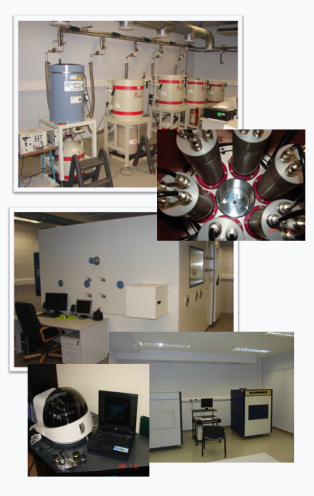
Short courses on research into radiation risks and radiation protection – sponsored by CONCERT: Series 4, 2018-19
Measurement techniques used in monitoring of naturally occurring radionuclides the two weeks training course organised by: Silesian Centre for Environmental
Radioactivity Central Mining Institute, Katowice (Poland), May 19th to June 2nd, 2019.
Primordial and cosmogenic natural radioactive elements are found throughout all environmental compartments and they are present elsewhere. They are the source of natural background radiation that has been around since before the dawn of life on earth. Hence, natural background radiation usually is not considered to be harmful either to humans or to other organisms. Therefore, from a formal point of view, this phenomenon is not subject to radiation protection. However, selective accumulation of radionuclides caused either by forces of nature or human activity often occurs, leading to significant increases in the amount of the radioactive elements enclosed in some materials present in human neighbourhoods. In such cases, exposure to radiation can reach a level that cannot be neglected from the radiation protection point of view. This was reflected in the published in 2013 Council Directive 2013/59/Euratom (European BSS), requiring that protection against natural radiation sources, should be fully integrated within the overall system of radiation protection.
There are about 50 natural radionuclides that may occur in different environmental compartments. Majority of them are members of natural decay series of uranium and thorium and subject to sequential decay. Complex combination of their half-lives, chemical properties of different elements created due to decay and its aggregate state, influence significantly behaviour of natural radioactivity in environment as well as in different technological processes. Finally, natural radionuclides are occurring as a radionuclide’s suites, emitting alpha, beta and gamma radiation, usually called NORM (Naturally Occurring Radioactive Material) which is difficult to monitor, and many measurement techniques must be applied to get proper existing exposure evaluation. Moreover, as radiation protection is focused only on radiation exposure above natural background, measurements of natural radionuclides must provide additional information helping one to distinguish which source of radiation is natural and which one should be considered as a source of risk.
The training course focuses on most aspects related to measurement techniques applicable for measurement of natural radionuclides in all matrices present in human either natural or working environment. Lectures (25 hours) and exercises (35 hours) in well-equipped laboratories will focus on:
- High resolution gamma spectrometry applied for radionuclides identification, activity concentration quantification and equilibrium/disequilibrium evaluation, including in situ measurements.
- Liquid scintillation spectrometry (LSC) measurements, combined with radiochemical preparation techniques that let one to get very good detection limits for alpha and beta emitting natural radionuclides, in application not only for analyses of relatively simple matrix like water, but also for more complex samples (sediments, biota etc.).
- Alpha spectrometry dedicated for specific natural radionuclides e.g. polonium.
- Radon and radon progeny (PAEC) measurement applied for indoor air quality control and occupational exposure under specific work conditions, especially in underground workplaces as mines or caves including aerosols size distribution and related effect on committed dose.

As still the lack of basic knowledge about natural radioactivity related risk is observed, the course program covers also interpretation of obtained results from occupational risk and environmental exposure perspectives. As in case of natural radionuclides often other radionuclide are directly measured that these one important for exposure to radiation evaluation (e.g. Bi-214 and Ra-226 or Rn-222 and its short-lived decay products) analysis of available data concerning external circumstances, the history of tested materials combined with hints given e.g. by observed equilibrium factors are extremely important for proper exposure situation assessment. The training course covers all such subjects and provide case studies pointing out sources of possible mistakes. Based on the great success of our previous courses in 2015, 2016 and 2017 we can present you a very interesting, balanced and multi-faceted program.
Important.
- Course participation is free of charge for participants.
- Participants will get free accommodation (double rooms in a hotel 2 stars standard) which is walking distance from the headquarters of the Central Mining Institute, where lectures and laboratory classes will take place
- A certificate of attendance will be issued at the end of the course
- The training course is conducted in English.
- According to extensive laboratory the number of participants is limited to 12.
Application.
The target group consists of MSc or PhD students in the scientific fields of physics, chemistry, life sciences, environmental protection/engineering as well as continuing education professionals interested in developing their capabilities and skills related to the direct measurement and assessment of NORM’s impact on work and the natural environment, as well as gathering extended knowledge necessary to manage, maintain and control technological processes involving NORM.
If you are interested in participating, please send your application consisting of:
- Brief CV
- Motivation letter for participating in the Training Course, which should indicate the academic/professional status of the applicant
- Application form
- Letter of recommendation from the applicant’s supervisor or employer.
via e-mail to Beata Wojcik bwojcik@gig.eu with a copy to Boguslaw Michalik bmichalik@gig.eu and use the subject line: “Application for Measurement techniques used in monitoring of naturally occurring radionuclides course – Katowice”
Deadline.
The deadline for the submission of applications is January 4th, 2019. Notification of acceptance or rejection will be sent by January 15st, 2019 at the latest.
Contact.
Boguslaw Michalik
bmichalik@gig.eu
Place Gwarkow 1, 40-166 Katowice
Phone: +48-32-259-2380
Looking forward to meeting you in Katowice!
Course Venue.
Główny Instytut Górnictwa (Central Mining Institute) – Silesian Centre For Environmental Radioactivity, Plac Gwarkow 1, Katowice